Keshigeyan Chandrasegaran
Re-thinking Temporal Search for Long-Form Video Understanding
Apr 03, 2025Abstract:Efficient understanding of long-form videos remains a significant challenge in computer vision. In this work, we revisit temporal search paradigms for long-form video understanding, studying a fundamental issue pertaining to all state-of-the-art (SOTA) long-context vision-language models (VLMs). In particular, our contributions are two-fold: First, we formulate temporal search as a Long Video Haystack problem, i.e., finding a minimal set of relevant frames (typically one to five) among tens of thousands of frames from real-world long videos given specific queries. To validate our formulation, we create LV-Haystack, the first benchmark containing 3,874 human-annotated instances with fine-grained evaluation metrics for assessing keyframe search quality and computational efficiency. Experimental results on LV-Haystack highlight a significant research gap in temporal search capabilities, with SOTA keyframe selection methods achieving only 2.1% temporal F1 score on the LVBench subset. Next, inspired by visual search in images, we re-think temporal searching and propose a lightweight keyframe searching framework, T*, which casts the expensive temporal search as a spatial search problem. T* leverages superior visual localization capabilities typically used in images and introduces an adaptive zooming-in mechanism that operates across both temporal and spatial dimensions. Our extensive experiments show that when integrated with existing methods, T* significantly improves SOTA long-form video understanding performance. Specifically, under an inference budget of 32 frames, T* improves GPT-4o's performance from 50.5% to 53.1% and LLaVA-OneVision-72B's performance from 56.5% to 62.4% on LongVideoBench XL subset. Our PyTorch code, benchmark dataset and models are included in the Supplementary material.
HourVideo: 1-Hour Video-Language Understanding
Nov 07, 2024
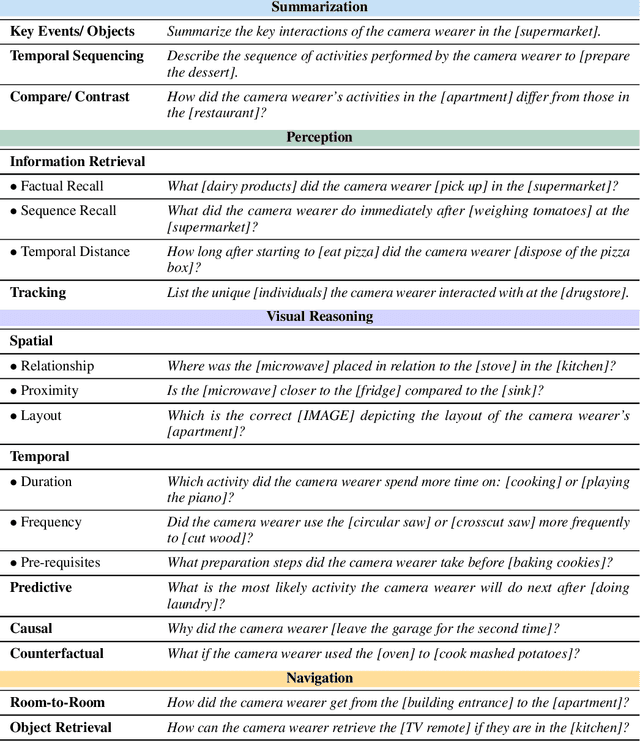

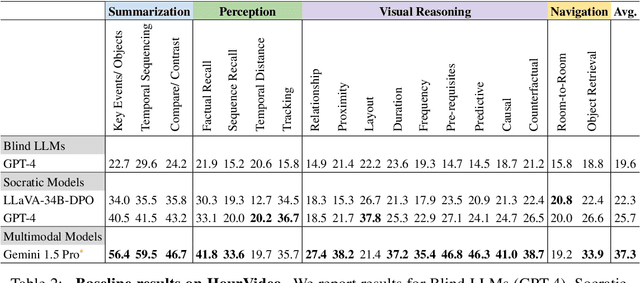
Abstract:We present HourVideo, a benchmark dataset for hour-long video-language understanding. Our dataset consists of a novel task suite comprising summarization, perception (recall, tracking), visual reasoning (spatial, temporal, predictive, causal, counterfactual), and navigation (room-to-room, object retrieval) tasks. HourVideo includes 500 manually curated egocentric videos from the Ego4D dataset, spanning durations of 20 to 120 minutes, and features 12,976 high-quality, five-way multiple-choice questions. Benchmarking results reveal that multimodal models, including GPT-4 and LLaVA-NeXT, achieve marginal improvements over random chance. In stark contrast, human experts significantly outperform the state-of-the-art long-context multimodal model, Gemini Pro 1.5 (85.0% vs. 37.3%), highlighting a substantial gap in multimodal capabilities. Our benchmark, evaluation toolkit, prompts, and documentation are available at https://hourvideo.stanford.edu
Model Inversion Robustness: Can Transfer Learning Help?
May 09, 2024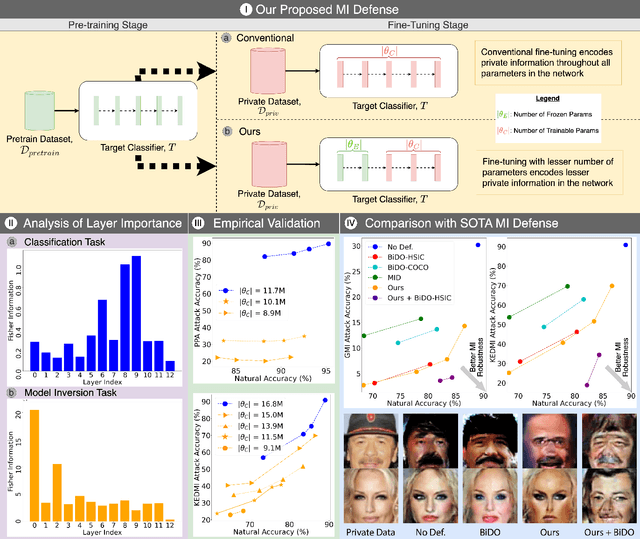

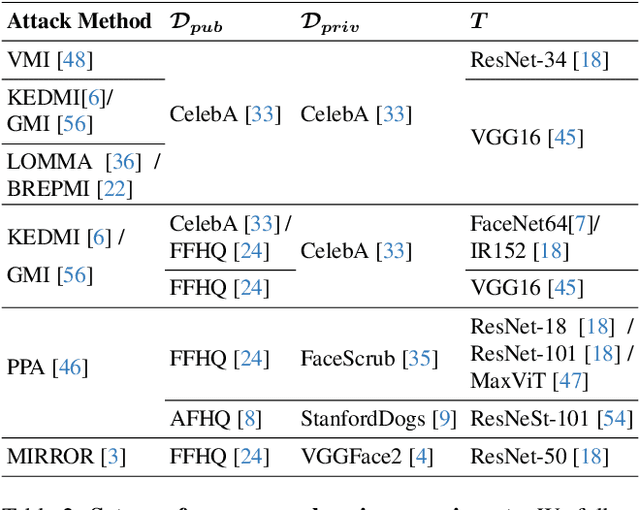
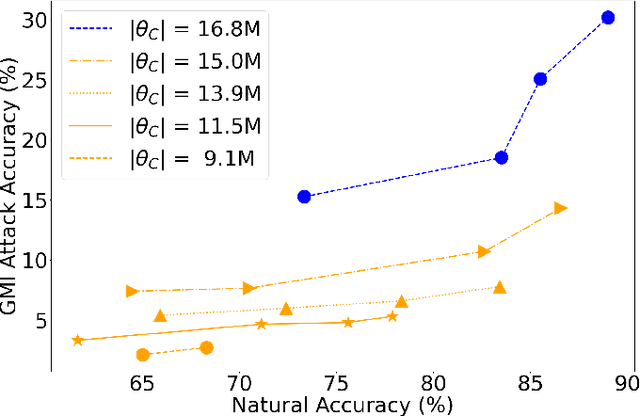
Abstract:Model Inversion (MI) attacks aim to reconstruct private training data by abusing access to machine learning models. Contemporary MI attacks have achieved impressive attack performance, posing serious threats to privacy. Meanwhile, all existing MI defense methods rely on regularization that is in direct conflict with the training objective, resulting in noticeable degradation in model utility. In this work, we take a different perspective, and propose a novel and simple Transfer Learning-based Defense against Model Inversion (TL-DMI) to render MI-robust models. Particularly, by leveraging TL, we limit the number of layers encoding sensitive information from private training dataset, thereby degrading the performance of MI attack. We conduct an analysis using Fisher Information to justify our method. Our defense is remarkably simple to implement. Without bells and whistles, we show in extensive experiments that TL-DMI achieves state-of-the-art (SOTA) MI robustness. Our code, pre-trained models, demo and inverted data are available at: https://hosytuyen.github.io/projects/TL-DMI
Label-Only Model Inversion Attacks via Knowledge Transfer
Oct 30, 2023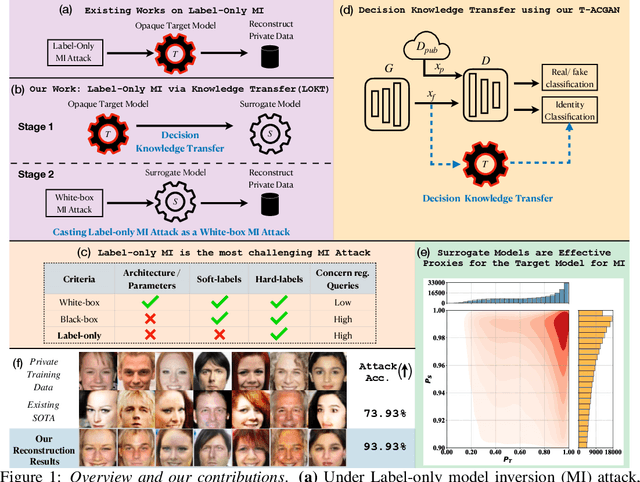
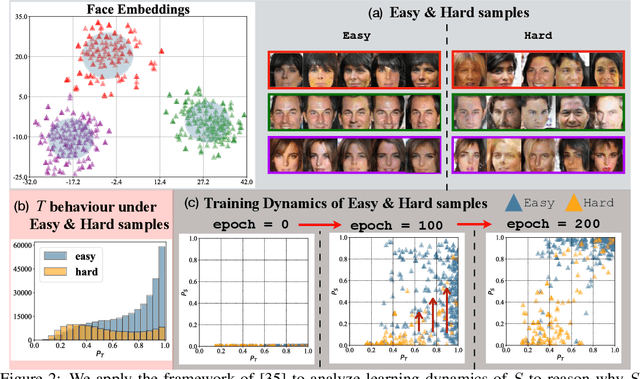
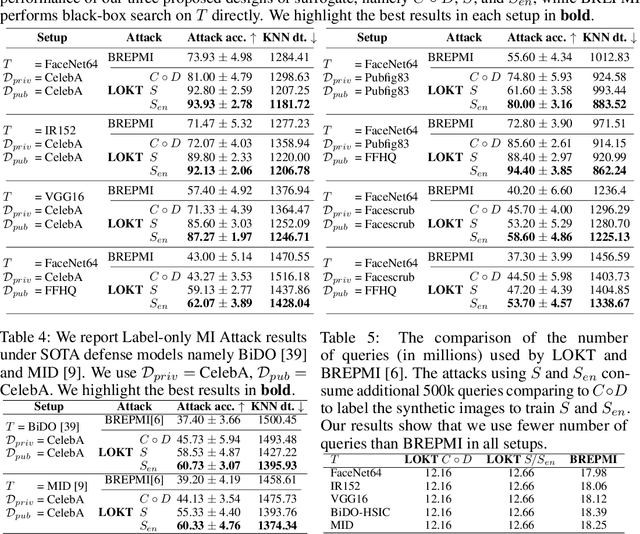
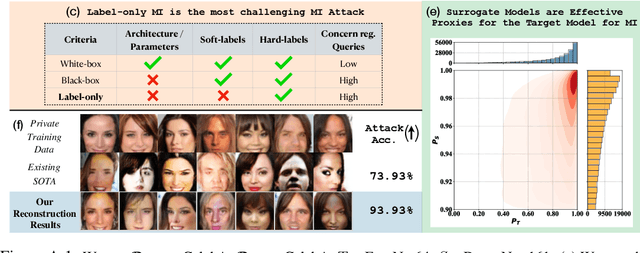
Abstract:In a model inversion (MI) attack, an adversary abuses access to a machine learning (ML) model to infer and reconstruct private training data. Remarkable progress has been made in the white-box and black-box setups, where the adversary has access to the complete model or the model's soft output respectively. However, there is very limited study in the most challenging but practically important setup: Label-only MI attacks, where the adversary only has access to the model's predicted label (hard label) without confidence scores nor any other model information. In this work, we propose LOKT, a novel approach for label-only MI attacks. Our idea is based on transfer of knowledge from the opaque target model to surrogate models. Subsequently, using these surrogate models, our approach can harness advanced white-box attacks. We propose knowledge transfer based on generative modelling, and introduce a new model, Target model-assisted ACGAN (T-ACGAN), for effective knowledge transfer. Our method casts the challenging label-only MI into the more tractable white-box setup. We provide analysis to support that surrogate models based on our approach serve as effective proxies for the target model for MI. Our experiments show that our method significantly outperforms existing SOTA Label-only MI attack by more than 15% across all MI benchmarks. Furthermore, our method compares favorably in terms of query budget. Our study highlights rising privacy threats for ML models even when minimal information (i.e., hard labels) is exposed. Our study highlights rising privacy threats for ML models even when minimal information (i.e., hard labels) is exposed. Our code, demo, models and reconstructed data are available at our project page: https://ngoc-nguyen-0.github.io/lokt/
A Survey on Generative Modeling with Limited Data, Few Shots, and Zero Shot
Jul 26, 2023
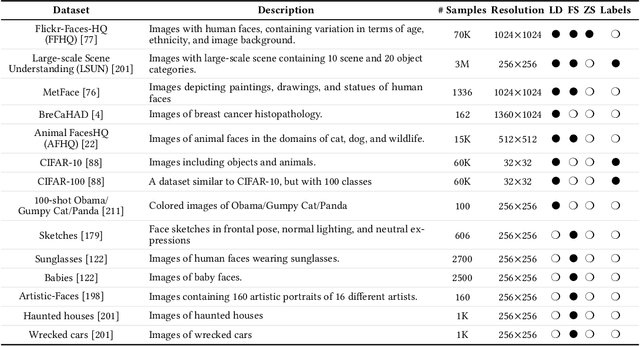

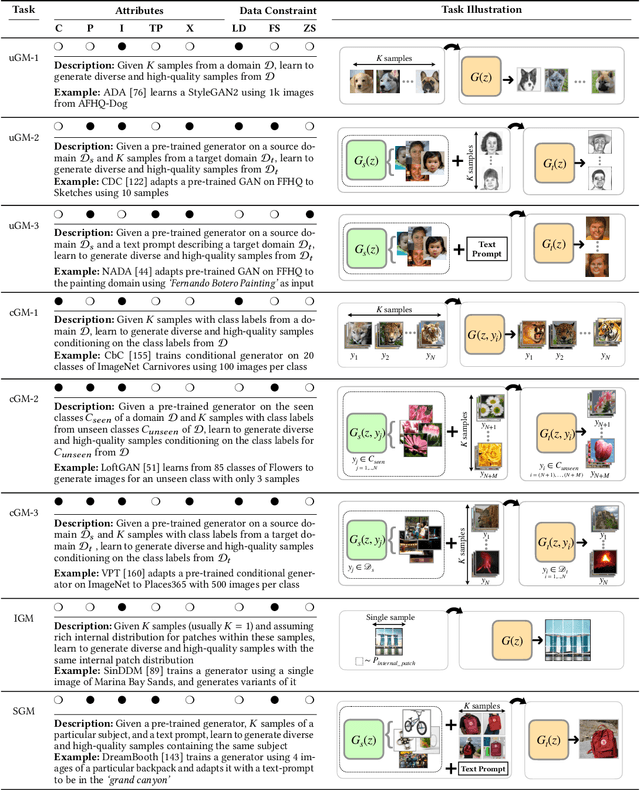
Abstract:In machine learning, generative modeling aims to learn to generate new data statistically similar to the training data distribution. In this paper, we survey learning generative models under limited data, few shots and zero shot, referred to as Generative Modeling under Data Constraint (GM-DC). This is an important topic when data acquisition is challenging, e.g. healthcare applications. We discuss background, challenges, and propose two taxonomies: one on GM-DC tasks and another on GM-DC approaches. Importantly, we study interactions between different GM-DC tasks and approaches. Furthermore, we highlight research gaps, research trends, and potential avenues for future exploration. Project website: https://gmdc-survey.github.io.
AdAM: Few-Shot Image Generation via Adaptation-Aware Kernel Modulation
Jul 08, 2023Abstract:Few-shot image generation (FSIG) aims to learn to generate new and diverse images given few (e.g., 10) training samples. Recent work has addressed FSIG by leveraging a GAN pre-trained on a large-scale source domain and adapting it to the target domain with few target samples. Central to recent FSIG methods are knowledge preservation criteria, which select and preserve a subset of source knowledge to the adapted model. However, a major limitation of existing methods is that their knowledge preserving criteria consider only source domain/task and fail to consider target domain/adaptation in selecting source knowledge, casting doubt on their suitability for setups of different proximity between source and target domain. Our work makes two contributions. Firstly, we revisit recent FSIG works and their experiments. We reveal that under setups which assumption of close proximity between source and target domains is relaxed, many existing state-of-the-art (SOTA) methods which consider only source domain in knowledge preserving perform no better than a baseline method. As our second contribution, we propose Adaptation-Aware kernel Modulation (AdAM) for general FSIG of different source-target domain proximity. Extensive experiments show that AdAM consistently achieves SOTA performance in FSIG, including challenging setups where source and target domains are more apart.
Re-thinking Model Inversion Attacks Against Deep Neural Networks
Apr 04, 2023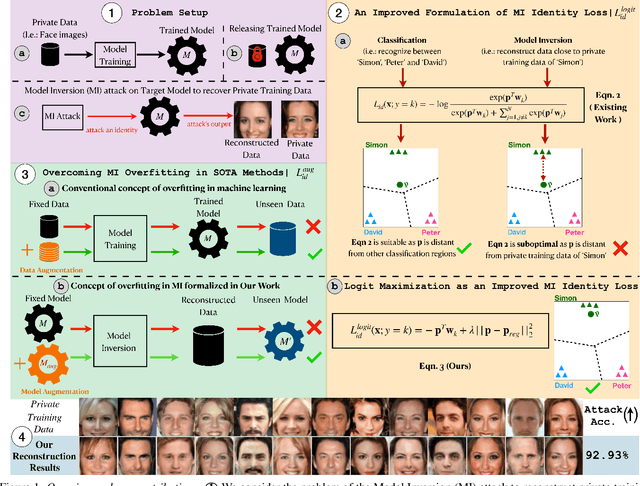
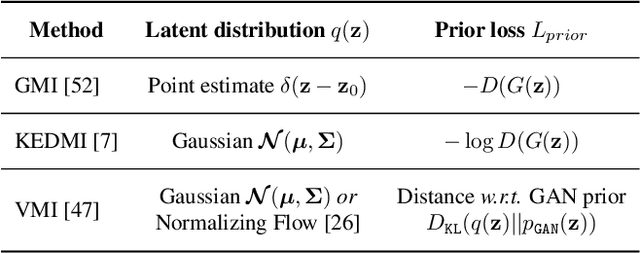
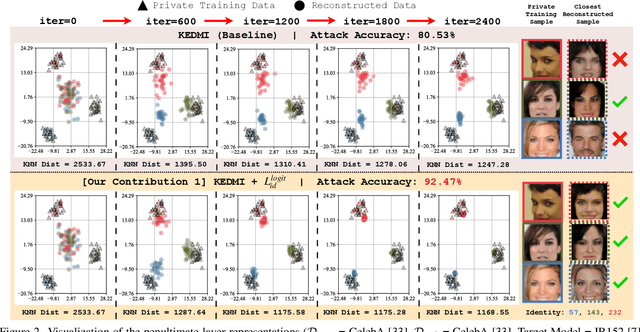

Abstract:Model inversion (MI) attacks aim to infer and reconstruct private training data by abusing access to a model. MI attacks have raised concerns about the leaking of sensitive information (e.g. private face images used in training a face recognition system). Recently, several algorithms for MI have been proposed to improve the attack performance. In this work, we revisit MI, study two fundamental issues pertaining to all state-of-the-art (SOTA) MI algorithms, and propose solutions to these issues which lead to a significant boost in attack performance for all SOTA MI. In particular, our contributions are two-fold: 1) We analyze the optimization objective of SOTA MI algorithms, argue that the objective is sub-optimal for achieving MI, and propose an improved optimization objective that boosts attack performance significantly. 2) We analyze "MI overfitting", show that it would prevent reconstructed images from learning semantics of training data, and propose a novel "model augmentation" idea to overcome this issue. Our proposed solutions are simple and improve all SOTA MI attack accuracy significantly. E.g., in the standard CelebA benchmark, our solutions improve accuracy by 11.8% and achieve for the first time over 90% attack accuracy. Our findings demonstrate that there is a clear risk of leaking sensitive information from deep learning models. We urge serious consideration to be given to the privacy implications. Our code, demo, and models are available at https://ngoc-nguyen-0.github.io/re-thinking_model_inversion_attacks/
Few-shot Image Generation via Adaptation-Aware Kernel Modulation
Nov 13, 2022Abstract:Few-shot image generation (FSIG) aims to learn to generate new and diverse samples given an extremely limited number of samples from a domain, e.g., 10 training samples. Recent work has addressed the problem using transfer learning approach, leveraging a GAN pretrained on a large-scale source domain dataset and adapting that model to the target domain based on very limited target domain samples. Central to recent FSIG methods are knowledge preserving criteria, which aim to select a subset of source model's knowledge to be preserved into the adapted model. However, a major limitation of existing methods is that their knowledge preserving criteria consider only source domain/source task, and they fail to consider target domain/adaptation task in selecting source model's knowledge, casting doubt on their suitability for setups of different proximity between source and target domain. Our work makes two contributions. As our first contribution, we re-visit recent FSIG works and their experiments. Our important finding is that, under setups which assumption of close proximity between source and target domains is relaxed, existing state-of-the-art (SOTA) methods which consider only source domain/source task in knowledge preserving perform no better than a baseline fine-tuning method. To address the limitation of existing methods, as our second contribution, we propose Adaptation-Aware kernel Modulation (AdAM) to address general FSIG of different source-target domain proximity. Extensive experimental results show that the proposed method consistently achieves SOTA performance across source/target domains of different proximity, including challenging setups when source and target domains are more apart. Project Page: https://yunqing-me.github.io/AdAM/
Discovering Transferable Forensic Features for CNN-generated Images Detection
Aug 24, 2022



Abstract:Visual counterfeits are increasingly causing an existential conundrum in mainstream media with rapid evolution in neural image synthesis methods. Though detection of such counterfeits has been a taxing problem in the image forensics community, a recent class of forensic detectors -- universal detectors -- are able to surprisingly spot counterfeit images regardless of generator architectures, loss functions, training datasets, and resolutions. This intriguing property suggests the possible existence of transferable forensic features (T-FF) in universal detectors. In this work, we conduct the first analytical study to discover and understand T-FF in universal detectors. Our contributions are 2-fold: 1) We propose a novel forensic feature relevance statistic (FF-RS) to quantify and discover T-FF in universal detectors and, 2) Our qualitative and quantitative investigations uncover an unexpected finding: color is a critical T-FF in universal detectors. Code and models are available at https://keshik6.github.io/transferable-forensic-features/
Revisiting Label Smoothing and Knowledge Distillation Compatibility: What was Missing?
Jun 29, 2022



Abstract:This work investigates the compatibility between label smoothing (LS) and knowledge distillation (KD). Contemporary findings addressing this thesis statement take dichotomous standpoints: Muller et al. (2019) and Shen et al. (2021b). Critically, there is no effort to understand and resolve these contradictory findings, leaving the primal question -- to smooth or not to smooth a teacher network? -- unanswered. The main contributions of our work are the discovery, analysis and validation of systematic diffusion as the missing concept which is instrumental in understanding and resolving these contradictory findings. This systematic diffusion essentially curtails the benefits of distilling from an LS-trained teacher, thereby rendering KD at increased temperatures ineffective. Our discovery is comprehensively supported by large-scale experiments, analyses and case studies including image classification, neural machine translation and compact student distillation tasks spanning across multiple datasets and teacher-student architectures. Based on our analysis, we suggest practitioners to use an LS-trained teacher with a low-temperature transfer to achieve high performance students. Code and models are available at https://keshik6.github.io/revisiting-ls-kd-compatibility/
 Add to Chrome
Add to Chrome Add to Firefox
Add to Firefox Add to Edge
Add to Edge